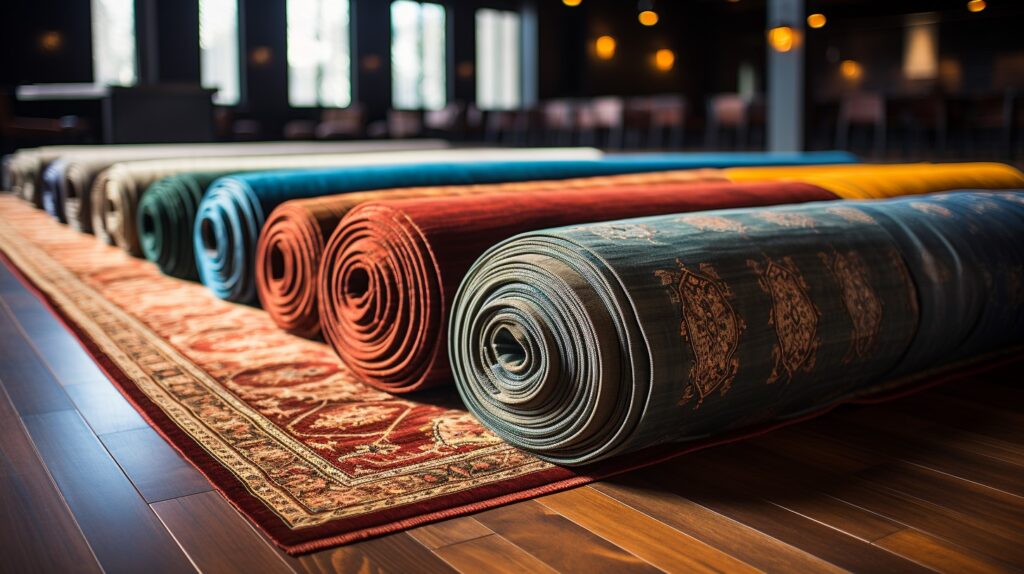
Introduction
In the tapestry of home décor, carpets have long held a place of prominence, not just as a statement of aesthetic appeal but also as a comfort underfoot. But as we become more conscientious about the products we use, the narrative is shifting. Amidst this evolution, organic carpets are stepping into the limelight, heralded not only for their natural beauty but also for the myriad of health benefits they tote. This surge in popularity isn’t merely a trend but a profound recognition of the need to foster healthier living spaces. Herein lies the purpose of this article: to weave through the facts and unfurl the health benefits that organic carpet materials offer those who tread upon them.
What Makes a Carpet “Organic”?
When we speak of organic carpets, we’re delving into a realm where nature meets craftsmanship. These carpets are the antithesis of synthetic counterparts, shunning the artificial for the authentic. To don the label ‘organic,’ a carpet must be composed of materials that are grown and harvested in strict adherence to organic agricultural standards. These standards eschew synthetic pesticides and fertilizers, ensuring that the fibers — whether they be wool, cotton, jute, sisal, or seagrass — remain as untainted by chemicals as the day they were harvested.
The distinction between natural and synthetic fibers is not just a matter of semantics; it’s a crucial differentiator regarding environmental impact, health implications, and sensory experience. Natural fibers are renewable and biodegradable, whereas synthetic fibers often contribute to environmental degradation. Each organic carpet fiber has unique attributes — wool with its luxurious softness, cotton with its understated strength, jute with its earthy texture, sisal with its rugged durability, and seagrass with its subtle sheen. Together, they form a rich palette from which stunning organic carpets are crafted.
The Health Perks of Going Organic with Your Carpets
Indoor air quality is a silent yet significant aspect of our living spaces. Traditional synthetic carpets can harbor a cocktail of volatile organic compounds (VOCs) — chemicals that evaporate at room temperature and can have short- and long-term adverse health effects. In contrast, organic carpets present fresh air free from VOCs; they contribute to a healthier indoor atmosphere, one less laden with pollutants.
But the benefits continue beyond there. Organic fibers inherently possess hypoallergenic properties. They resist dust mites, mold, and mildew — common triggers for allergies and respiratory issues. This makes organic carpets a sanctuary for those who suffer from allergies or asthma, offering a reprieve from the sneeze-inducing grip of allergens.
Additionally, the absence of harsh chemicals means that organic carpets are gentler on the skin. They provide a safe play surface for children and a nontoxic resting place for pets. Moreover, certain organic materials naturally possess antimicrobial properties, which impede the growth of bacteria and fungus, ensuring that the carpet not only looks clean but genuinely harbors fewer germs.Organic Carpets and Long-Term Health Implications

The advantages of choosing organic carpets echo far beyond the immediate tactile and visual gratification. They are an investment in respiratory health. In a world where indoor air quality can be more polluted than outdoor air, selecting a carpet devoid of toxins can significantly impact one’s health trajectory, particularly for the young, the elderly, and those with compromised immune systems.
For allergy sufferers, an organic carpet can mean the difference between comfort and constant irritation. By providing a natural barrier against allergens, these carpets can markedly reduce symptoms and improve the quality of life. Furthermore, they create a nontoxic living environment — an increasingly vital aspect as we spend more time indoors.
On a broader scale, the role of organic carpets in overall well-being can be profound. Our homes are our sanctuaries, and every element can contribute to our sense of peace and well-being. An organic carpet, with its natural fibers and lack of chemicals, supports a holistic approach to health, aligning our living spaces with our wellness goals.
The Environmental Edge of Organic Carpets
Organic carpets represent a triumph not just for indoor health but also for the environment. The production process for organic materials is intrinsically eco-friendly. It consumes less water and energy than the manufacturing of synthetic fibers and sidesteps the pollution associated with pesticides and fertilizers.
These carpets’ biodegradability is another feather in their environmental cap. Unlike synthetic rugs that linger in landfills for centuries, organic carpets can decompose naturally, leaving minimal ecological footprints. Their life cycle, from creation to disposal, harmonizes with the rhythms of nature, offering a sustainable option for eco-conscious consumers.
By choosing organic carpets, individuals can take an active stance in promoting global health. Each purchase supports agricultural practices that are in harmony with the planet, encouraging a shift towards more sustainable farming methods. In the grander scheme, this consumer choice can ripple outward, influencing industry standards and contributing to the protection of our planet for future generations.
Choosing the Right Organic Carpet for Your Home
Incorporating an organic carpet into your living space is the first step towards a healthier home environment. However, it is essential to navigate this choice with care. The selection process should factor in not only the material but also the dyes and finishes used, as these, too, can carry chemicals that undermine the health benefits of organic fibers. Opt for carpets dyed with natural or low-impact dyes and avoid those treated with mothproofing chemicals or stain protectants, as these can introduce unwanted toxins into your home.
Furthermore, consider the sustainability and ethical practices of the brand or artisans creating the carpet. Beyond the health implications, the social and environmental ethos of the manufacturer can add a layer of satisfaction to your purchase, knowing that you’re supporting responsible trade practices.
When selecting an organic carpet, consider the texture and pile height. These factors not only contribute to the aesthetic and feel underfoot but also to the ease of cleaning and maintenance. A lower pile height may attract less dust and be more straightforward to keep clean, thus promoting a healthier living environment.
The Maintenance of Organic Carpets
Maintaining the pristine condition and health benefits of an organic carpet requires a thoughtful approach. Regular vacuuming with a HEPA filter vacuum cleaner is recommended to remove dust and allergens without re-releasing them into the air. In spills, immediate attention to natural cleaning agents is critical to preventing stains without resorting to harsh chemicals.
Professional cleaning is also an important consideration. Seeking out services that specialize in organic carpet care and use eco-friendly cleaning methods can extend the life of your carpet and ensure that it remains a beneficial part of your home’s ecosystem.
Innovations and Future Trends in Organic Carpeting
The future of organic carpeting is vibrant and promising. Innovations in organic fibers and eco-friendly manufacturing processes are continuously emerging, paving the way for an even more comprehensive array of choices for health-conscious consumers. Developments in organic adhesive and backing materials are also evolving, making these carpets more durable and long-lasting while still maintaining their nontoxic status.
Moreover, the market for recycled and upcycled materials is growing, with some organic carpets now being made from reclaimed natural fibers. This not only minimizes waste but also offers a unique story behind each carpet, adding character and conversation to your living space.
The demand for transparency in the supply chain also influences the organic carpet industry. Consumers are increasingly interested in tracing the journey of their carpets from the source of the fibers to the finished product in their homes. This scrutiny is prompting manufacturers to adopt more transparent practices and to seek certifications that validate their eco-friendly and health-conscious claims.Healthier Homes, Healthier Planet: The Bigger Picture

The significance of choosing organic carpets extends beyond individual homes and personal health. It’s part of a larger narrative about consumer choices and their impact on the planet’s health. Every organic carpet laid down is a testament to growing awareness and a collective move towards more sustainable living practices.
As individuals become more attuned to the environmental and health impacts of their purchasing decisions, industries are motivated to innovate and adapt. This is evident in the rising number of organic carpet options available in the market, each catering to the discerning needs of eco-conscious homeowners.
In embracing organic carpets, we are not only nurturing our health but also casting a vote for the kind of world we want to live in. It’s a world where the environment’s well-being is inextricably linked to our own and where our choices in our most intimate spaces reflect our broader values.
Conclusion
To choose an organic carpet is to step onto a path of conscious living. It’s an investment in a lifestyle that values health, sustainability, and the intrinsic beauty of nature’s offerings. As the threads of environmental responsibility and personal well-being become increasingly intertwined, organic carpets stand out as a symbol of this harmonious blend. They are not merely a fixture within our homes but a statement of our commitment to a healthier, more sustainable future — for ourselves and the planet.